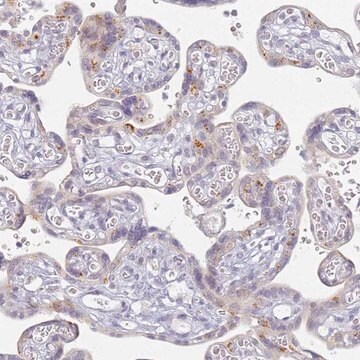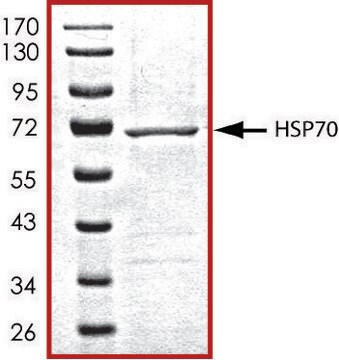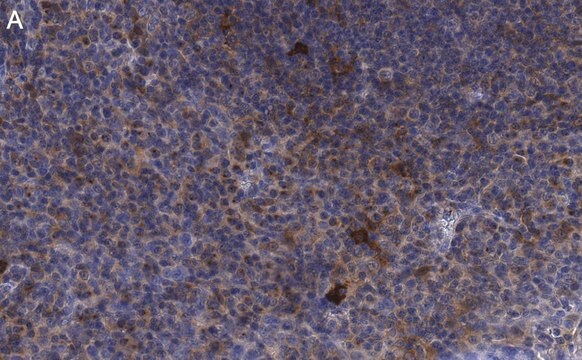일반 설명
We are committed to bringing you greener alternative products, which adhere to one or more of The 12 Principles of Green Chemistry. This antibody is Preservative-free, produced without the harm or sacrifice of animals and exceptionally stable to allow for ambient shipping and storage if needed and thus aligns with "Waste Prevention", "Designing Safer Chemicals" and "Design for Energy Efficiency".
Click here for more information.
ZooMAb® antibodies represent an entirely new generation of recombinant monoclonal antibodies. Each ZooMAb® antibody is manufactured using our proprietary recombinant expression system, purified to homogeneity, and precisely dispensed to produce robust and highly reproducible lot-to-lot consistency. Only top-performing clones are released for use by researchers. Each antibody is validated for high specificity and affinity across multiple applications, including its most commonly used application. ZooMAb® antibodies are reliably available and ready to ship when you need them.
특이성
Clone 1M19 is a ZooMAb® rabbit recombinant monoclonal antibody that specifically detects LAMTOR1. It targets an epitope within 15 amino acids from the internal region.
면역원
KLH-conjugated linear peptide corresponding to 15 amino acids from the internal region of human LAMTOR1.
애플리케이션
Quality Control Testing
Evaluated by Western Blotting in PANC-1 cell lysate.
Western Blotting Analysis: A 1:1,000 dilution of this antibody detected LAMTOR1 in PANC-1 cell lysate.
Tested Applications
Affinity Binding Assay: A representative lot of this antibody bound LAMTOR1 peptide with a KD of 5.7x 10-6 in an affinity binding assay.
Immunohistochemistry (Paraffin) Analysis: A 1:100 dilution from a representative lot detected LAMTOR1 in Human kidney tissue sections.
Immunocytochemistry Analysis: A 1:100 dilution from a representative lot detected LAMTOR1 in PANC-1 cells.
Note: Actual optimal working dilutions must be determined by end user as specimens, and experimental conditions may vary with the end user.
표적 설명
Regulator complex protein LAMTOR1 (UniProt: Q6IAA8; also known as Late endosomal/lysosomal adaptor and MAPK and MTOR activator 1, Lipid raft adaptor protein p18, Protein associated with DRMs and endosomes, p27Kip1-releasing factor from RhoA, p27RF-Rho) is encoded by the LAMTOR1 (also known as C11orf59, PDRO, PP7157) gene (Gene ID: 55004) in human. LAMTOR1 is a lipid-anchor protein present in late endosomes, lysosomes, and cell membrane. It is a component of the pentameric Ragulator complex that consists of LAMTOR1-5 and plays a critical role in lysosomal recruiting and activation of mTORC1. The Ragulator complex is involved in promoting cell growth in response to growth factors, energy levels, and amino acids. It is activated by amino acids through a mechanism involving the lysosomal V-ATPase. The Ragulator functions as a guanine nucleotide exchange factor activating the small GTPases Rag. Activated Ragulator and Rag GTPases function as a scaffold recruiting mTORC1 to lysosomes where it is in turn activated. LAMTOR1 is directly responsible for anchoring the Ragulator complex to membranes. It is also required for late endosomes/lysosomes biogenesis and may regulate both the recycling of receptors through endosomes and the MAPK signaling pathway through recruitment of some of its components to late endosomes. USP32 is reported to deubiquitinate LAMTOR1 at lysine 20, which leads to its accumulation and increased interaction with lysosomal v-ATPase and mTORC1 activation that reduces autophagy induction. The Ragulator complex expression is also observed in immune cells, and a deficiency of LAMTOR1 in macrophages is known to cause mTORC1-dependent impairment of M2 macrophage polarization due to aberrant lipid metabolism.. The lack of LAMTOR1 leads to reduced phosphorylation of S6K and lower levels of the LXR ligand, 25-hydroxycholesterol, which results in the expression of LXR-dependent genes that are important for the differentiation of M2 macrophages. This ZooMAb® recombinant monoclonal antibody, generated by our propriety technology, offers significantly enhanced specificity, affinity, reproducibility, and stability over conventional monoclonals. (Ref.: Sun, J., et al. (2022). EMBO J. 41; e108119; Hertel, A., et al. (2022). Cell Rep. 41(10); 111653; Nakatani, T., et al. (2021). Nat. Commun. 12; Article 3333; Sancak, Y., et al. (2010). Cell.141(2); 290-303).
물리적 형태
Purified recombinant rabbit monoclonal antibody IgG, lyophilized in PBS, 5% Trehalose, normal appearance a coarse or translucent resin. The PBS/trehalose components in the ZooMAb formulation can have the appearance of a semi-solid (bead like gel) after lyophilization. This is a normal phenomenon. Please follow the recommended reconstitution procedure in the data sheet to dissolve the semi-solid, bead-like, gel-appearing material. The resulting antibody solution is completely stable and functional as proven by full functional testing. Contains no biocide or preservatives, such as azide, or any animal by-products. Larger pack sizes provided as multiples of 25 µL.
재구성
300 µg/mL after reconstitution at 25 µL per vial. Please refer to guidance on suggested starting dilutions and/or titers per application and sample type.
저장 및 안정성
Recommend storage of lyophilized product at 2-8°C; Before reconstitution, micro-centrifuge vials briefly to spin down material to bottom of the vial; Reconstitute each vial by adding 25 µL of filtered lab grade water or PBS; Reconstituted antibodies can be stored at 2-8°C, or -20°C for long term storage. Avoid repeated freeze-thaws.
기타 정보
Concentration: Please refer to the Certificate of Analysis for the lot-specific concentration.
법적 정보
ZooMAb is a registered trademark of Merck KGaA, Darmstadt, Germany
면책조항
Unless otherwise stated in our catalog or other company documentation accompanying the product(s), our products are intended for research use only and are not to be used for any other purpose, which includes but is not limited to, unauthorized commercial uses, in vitro diagnostic uses, ex vivo or in vivo therapeutic uses or any type of consumption or application to humans or animals.










